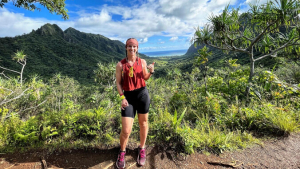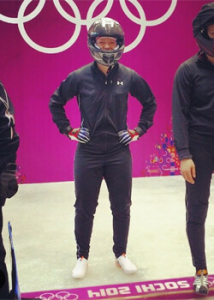
One of the standout bobsledders in United States history has started the next chapter of her life at the University of Hawaiʻi at Mānoa, pursuing a doctor of nursing practice degree from the Nancy Atmospera-Walch School of Nursing (NAWSON).
Kristi Koplin spent 10 years at the height of the sport, winning gold medals at multiple North American Cup competitions, and making it to the 2014 Winter Olympics in Sochi as an alternate for Team USA. However, a career ending injury early in 2020 forced Koplin to retire soon after she began contemplating a run to the 2022 Winter Olympics in Beijing.
Koplin earned her bachelor of science in nursing from Southern Utah University in 2010 and completed multiple assignments working as a nurse in the U.S. Army during her bobsled career. After suffering the injury in 2020, Koplin worked in clinics in Utah, Arizona and Pennsylvania during the beginning of the COVID-19 pandemic. It was then that she decided to apply to graduate school to become a nurse practitioner.
“I was just working and applied to three different schools and heard from UH first,” Koplin said. “I remember getting the letter saying that I needed to respond by December and I hadn’t heard from the other two schools so I just felt like it was meant to be.”
Coming full circle

Transitioning to life in Hawaiʻi wasn’t as difficult as you may think for the native from Park City, Utah. While she needed to get used to living permanently in warm temperatures, Koplin was familiar with the islands, as she and her family regularly visited Hawaiʻi and took “space available” flights to Hickam Air Force Base with the military.
“I remember coming [to Hawaiʻi] as a kid and having the fondest memories,” Koplin said. “I remember seeing Tripler and thinking ‘I want to work at the pink hospital.’ For me, it felt like this full circle coming together to come to Hawaiʻi and go to grad school. I’m grateful to have the GI Bill to pay for school and housing.”
Koplin is in her second year in the NAWSON program and is expected to graduate in 2024. Aside from school, she works at UH Mānoa’s Hyperbaric Treatment Center, located at the Kuakini Medical Center.
“I really enjoy it. I like hands-on learning so I’m glad that we’re in person mostly. Going to clinical I get to do things and learn with my hands. That’s the way I learn best,” Koplin said. “I was a collegiate athlete and then a bobsledder and everything I have ever done was with my hands.”
Koplin added, “My biggest goal is to help other people with my degree. I have lots of options. I could go back to active duty and I think that would be a good opportunity to help soldiers and their family members. But I’ve also thought about working at the VA for the same reason. My dad is a veteran and I have a lot of military people in my family so I just have a heart for the vet community.”
Koplin’s bobsledding career

Koplin excelled in track and field at Southern Utah University, racking up a number of school records in hammer, discus and weight throw. After her senior year of college, Koplin received an email from 2010 Olympic bronze medalist Elana Meyers introducing her to bobsled. Koplin attended a recruitment camp soon after and began the sport in late 2010.
“I just looked at it as this adventure and I always have loved roller coaster rides so I just instantly was like ‘yeah, I would love to do it.’ I knew it would be exciting and thrilling,” Koplin said. “I was in ROTC in my undergrad and my commander was supportive…I made the national team in my first year. Everything kind of worked out. I was able to juggle being active duty military and bobsledding with the help of the World Class Athlete Program.”
Koplin added, “Looking back on it now, I’m so grateful that they were like ‘you need to do your nursing too.’ When you’re done with professional sport life you need to have a real life plan.”
Koplin was a brakeman leading up to the 2014 Winter Olympics. She described it as a difficult but great year because she needed to fight for a spot on the Olympic team. While there were five total brakemen on the national team, just three competed at the Olympics in 2014. Even though Koplin wasn’t one of them, she was invited to Sochi as an alternate.
“It was bittersweet because you put in all this effort and time and it just kind of ends. But the stress is relieved as well because you wanted it so bad,” Koplin. “I met the nicest people there. I felt pretty safe and we got to support our team and also support other teams that were competing there.”
After her Olympic journey, Koplin went back to being a full-time nurse in the Army. She also switched to piloting the bobsled as she competed for more than five years in national events in the U.S.
“The experience made me realize how important it is to know what your passion is and go for it,” Koplin said. “I had a lot of things going on, nursing, military and I was piloting, so it just made me realize that to be great at something you have to give it everything you’ve got.”
Despite hanging up the sled for surgical scrubs and gloves, Koplin said she won’t be able to lose the competitive mindset, always looking for her next chance to cross the finish line with a gold medal in whatever activity it may be.
“Even now, I’m 36-years-old and I’m still trying to find that competition that I can compete in. It’s just a lifelong thing that you need to try to pursue if you enjoy it,” Koplin said.
—By Marc Arakaki

